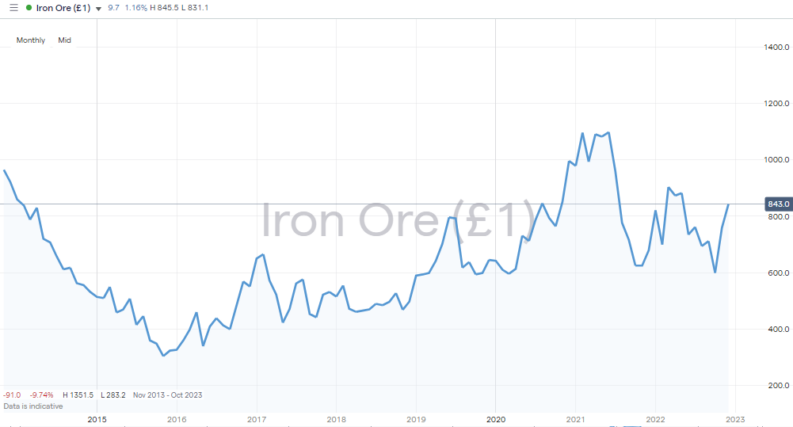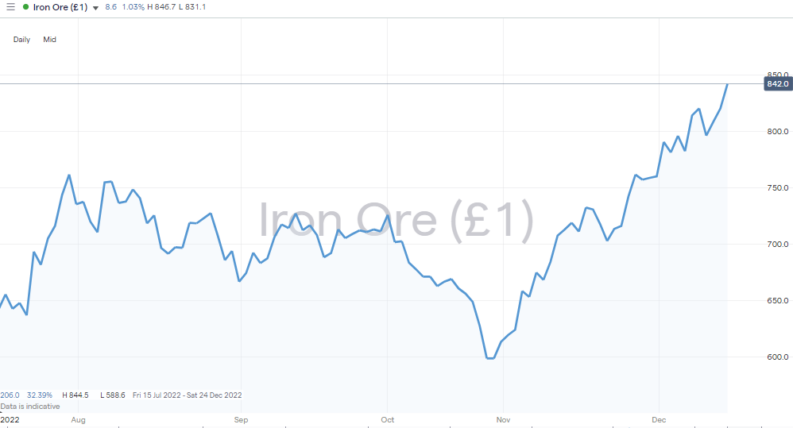Steel is one of the core components of economic activity. It’s used to make the cars we drive and the buildings we work and play in. As a result, a global market has developed to allow major corporations to buy and sell steel.
YOUR CAPITAL IS AT RISK
Traders with a view on how the price of steel will move can also trade the metal. There are various ways to get exposure to the sector, and this guide will break down the pros and cons of each and how to trade steel.
Table of contents
What is Steel
Steel is a metal created from iron ore and other elements, such as chromium, to make an end product that is very strong and durable. There are several types of steel, and the composition depends on the combination of elements that are combined with iron. Steel is generally traded as a raw material, but the secondary market supports trade in recycled and steel traded as scrap metal.
Steel is considered a ferrous metal, and in some circles, it is categorised as a base metal. Due to its strength, it is used in infrastructure, including buildings, cars, trains, ships, and weapons. The different types of steel products produced include Long Products, Semi-finished Products, Flat Products, Hot Rolled Plates, and Rolled Coils.
Steel Demand and Supply
While traders can speculate on the price of steel, the core trading activity is carried out by parties who buy and sell steel to use it in industrial activity. The list of major steel decision makers in the market includes the purchasing managers of big corporations, the sales managers at producers, logistics managers, and brokers.
Sectors of the economy that are active in the steel market include automobile manufacturers, construction companies, aerospace concerns, weapons manufacturers, power and energy producers, electrical equipment manufacturers, rail production, shipyard builders, as well as hedgers and speculators.

YOUR CAPITAL IS AT RISK
How to Trade Steel
Traders who buy and sell steel for speculative purposes make up a relatively small percentage of total global trade in the market. But if you’re looking to trade steel as a way of taking a view on the broader economy, there are a variety of ways to get exposure to the market.
Unlike crude oil, natural gas, and other metals such as gold, there is a greater variety of steel products available to trade. It is not as commoditised as some other natural resources. This is because, during the manufacturing processes, varying techniques are used to come up with different finished products which are used for their own purposes.
Steel can be traded, or alternatively, it is possible to trade iron ore, which is the main ingredient in steel products. We’ll consider the different ways of doing both.
Steel futures contracts are actively traded on exchanges such as the London Metals Exchange (LME) and the Chicago Mercantile Exchange. The LME provides traders with multiple steel contracts, including scrap metal and steel rebar. Futures commit the holder to buy or sell a quantity of steel at a predetermined date.
The exchanges also offer traders the option of taking delivery in several different locations, including North America, China, and the European Union – steel prices can vary from region to region depending on local demand and supply.
An option contract settles into the futures contracts and provides the owner with the right but not the obligation to purchase a futures contract at a specific price on or before a certain date.
Futures trading on exchanges is far from an entry-level way to trade steel. The trading activity is dominated by large corporations, brokers, and finance firms, and barriers to entry include having sufficient capital to deposit as collateral.
While exchanges are where the global price of steel is determined, other brokers take that price feed from the exchange and offer their clients more user-friendly ways of investing in steel.
Exchange Traded Funds (ETFs) are baskets of assets, and some have been created to hold financial instruments relating to the steel sector. The constituent parts of a stell ETF can include steel products, iron ore, or stocks of companies which operate in the sector.
The VanEck Vectors Steel SLX ETF gives investors exposure to “publicly traded companies primarily involved in steel production, including the operation of manufacturing mills, fabrication of productions, and the extraction and reduction of iron ore”.
Source: VettaFi
As ETFs are passive funds that track a market rather than try and beat it, they tend to have low running costs. If you want to really cut back on admin costs, then another option is to buy steel stocks outright and hold them in a share dealing account.
Good brokers offer markets in stocks of steel producers such as Tata Steel Ltd (TATA), Japan Steel Works Ltd (5631), or United States Steel Corp (X). It’s also possible to focus on the greener end of the market and buy stocks of steel recyclers such as Commercial Metals (CMC) PureCycle Technologies, Inc. (PCT), and Harsco Corporation (HSC).
Iron ore can be traded in CFD form at online brokers. Firms such as IG offer markets in iron ore as well as other base metals, including copper, zinc, aluminium, lead, and nickel. CFDs are versatile instruments that allow traders to go short or use leverage, but the daily financing charges associated with them mean they appeal to short-term speculators rather than buy-and-hold investors.

YOUR CAPITAL IS AT RISK
Final Thoughts
Steel markets might not be everyone’s first choice of investment opportunity. But buying the metal or other instruments related to the sector offers a way to gain exposure to one of the most crucial parts of the economic system.
Price moves can be dramatic. The classic cycle of economic boom and bust plays a part in triggering long-term trends. In addition, there is also the shift to a low-carbon global economy to consider. The remodelling of the world’s infrastructure will require massive amounts of steel, but much of the impetus for that move is provided by governments which can change their policies in an instant.
Another risk to consider is the reliability of your broker. This list of trusted brokers includes firms that have been reviewed by AskTraders analysts to ensure they offer all the tools and services, which will help you get your oil trading off to the best possible start.










